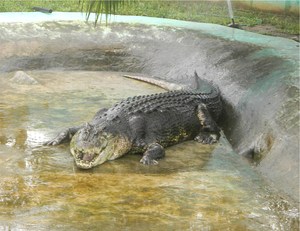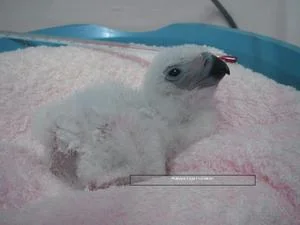Lolong - the longest saltwater crocodile in the Philippines - died prematurely earlier this year. Its death triggered many questions. What does it take to save endemic species such as saltwater crocodiles and the Philippine eagle? What factors cause species decline? Henrylito D. Tacio reports.
Davos, 8 May 2013. In February this year, two events hogged the headlines: the death of “Lolong” (touted to be the world’s biggest reptile in in captivity) and the birth of still unnamed eaglet (sired by the first Philippine eagle bred in captivity).
Lolong is no longer the largest saltwater crocodile alive due to poor environmental and captivity conditions in the Philippines.
On February 10, at 8:12 p.m., the 20.4 foot (6.12 meters) saltwater crocodile was declared dead by Dr. Alexander Collantes, animal doctor at the Davao Crocodile Park at its pen in barangay Consuelo of Bunawan, Agusan del Sur.
He refused to eat since last month and we noticed a change in the color of his faeces,” Bunawan Mayor Edwin “Cox” Elorde was quoted as saying. “Our personnel also noticed an unusual ballooning of the reptile’s belly.”
After Typhoon Pablo hit Agusan del Sur and other parts of Mindanao last December 2012, “Lolong” (named after a local crocodile hunter) reportedly showed unusual changes. “We checked him up last January 23 and we thought his condition would improve.
From a creek to an enlarged tub, Lolong lived out the rest of his days entertaining tourists.
We’re very saddened this happened,” the mayor said, adding that the crocodile was last observed “as very active” on Saturday night (February 9).
“Lolong suffered and died because people wanted to make money off his captivity,” People for the Ethical Treatment of Animals (PETA) said in a statement.
“Philippine Daily Inquirer, in a news report, quoted the mayor that the nature park where the crocodile had been kept was drawing hundreds of eager local tourists daily, generating up to P20,000 of gate receipts per day.
“Lolong” was caught in a Magsagangsang Creek in barangay Nueva Era in Bunawan, Agusan del Sur on September 3, 2011. Two months later, Australian crocodile expert Adam Britton of “National Geographic” sedated and measured “Lolong” in his enclosure
Before the year was over, the Guinness Book of World Records certified it as the world’s largest crocodile in captivity. It delisted the previous record-holder, the 5.48-meter long Cassius, which is kept in the crocodile park in Australia’s Northern Territory.
Pangil, a 5.4m saltwater crocodile, like the late Lolong, is held captive in unnatural and inadequate setting at the Davao Crocodile Park.
With the death of “Lolong,” the 18-foot long (5.4 meters) “Pangil” (fang) is now the country’s largest reptile in captivity. The saltwater crocodile can be seen up close at the Davao Crocodile Park in Davao City.
Reptile enthusiasts from all over the globe have traveled to the Philippines to check out their exhibition of crocodiles. The crocodiles in captivity here are fed numerous times a day and get to roam around lush green grasslands.
The animals in Davao are exotic but respected with high regard. If you want to check out a tropical paradise that offers great wildlife then book a cheap Davao hotel and head over to the Davao Crocodile Park. Pangil, the newest addition to large reptiles is present for visitors to view due to the unfortunate passing of “Lolong”.
However, a day before the death of “Lolong,” on February 9, a 158-gram chick was hatched in the Philippine Eagle Center in Malagos, Calinan in Davao City.
The eaglet reportedly had to be assisted to successfully break from its shell. “The chick hatched from a breeched position so I had to help it to avoid damaging the vital veins that could potentially cause its death,” recalled Anna Mae Sumaya, the curator for conservation breeding of the Philippine Eagle Foundation (PEF).
Normally, chicks pip through the upper part of the egg, the broad end, where the air space is located. But in this case, the chick started to crack the shell on its side. Sumaya decided to assist the chick to keep it hurting or even killing itself.
At 1:55 am, about 48 hours after it began to break its shell, the chick completely hatched.
PEF executive director Dennis Salvador said the center waited four days to announce the hatching of the eaglet because they wanted to make sure the chick would survive.
It took 21 years for “Pag-asa” (hope) to sire the eaglet.
Breeding eagles in captivity is hard work and not always successful.
“Pag-asa” was the result of a long and tedious work of the PEF to save the endangered “Pithecophaga jefferyi,” described by American aviator Charles Lindbergh as “the world’s noblest flier.”
“This (recent) accomplishment underscores the fact breeding these birds in captivity remains difficult. We are certainly a long way off in coping with losses in the wild. The Philippine eagles and their forest habitat continue to be imperiled by man-made activities like logging, mining and other development projects,” deplored Salvador.
“The Philippine eagle has become a critically endangered species because the loss of the forest had made it lose its natural habitat,” he added.
Studies show a pair of Philippine eagle needs at least 7,000 to 13,000 hectares of forest as a nesting territory.
The captive breeding is one of the eagle center’s top programs as its main objective is to augment wild populations of the endangered bird while serving as a “genetic insurance” for the species.
The Philippine eagle pair needs 7,000 to 13,000 hectares of forest as nesting territory. Deforestation, as such, continues to be a major threat that could possibly lead these birds to extinction.
Studies conducted by the center indicate that more than 90% of fledglings and juveniles do not reach breeding age or adulthood primarily because of human persecution (mainly shooting followed by trapping-capture incidents).
A Philippine eagle is considered adult when it reaches the age of six to seven years.
If the old breeding pairs in the wild are not being replaced, Salvador explained, it is more likely that the whole Philippine eagle population could suddenly collapse. “Before we know it, we’d probably lose the Philippine eagle. We’ll have a national bird that doesn’t exist,” he warned.
Both the Philippine eagle and the two types of crocodiles are endemic to the Philippines.
And both wildlife species are on the verge of extinction. “Extinction is forever,” said the UN Food and Agriculture Organization.
The Philippines is one of the world’s richest depositories of biological diversity (biodiversity), but its marine and wildlife riches are under threat because of intrusive man-made activities, according to Undersecretary Demetrio Ignacio of the Department of Environment and Natural Resources (DENR).
“The Philippines is one of the most threatened in the world. The rate of extinction of species is 1,000 times the natural rate because of manmade activities,” Ignacio said.
“It is a crisis. We are the hottest of the hot spots.”
The Philippines is the world’s second largest archipelago country after Indonesia. It comprises more than 7,100 islands covering 297,179 square kilometers in the westernmost Pacific Ocean. The country has 400 out of 500 coral species known in the world.
Despite being tagged as one of the “hottest of the hotspots,” Dr. Terrence Gosliner, dean of science and research collections at the California Academy of Sciences who headed the 2011 Philippine Biodiversity Expedition, believed that the biodiversity in the Philippines remains relatively unknown.
He’s not alone; many scientists think that many new species remain to be discovered in the country.
Just recently, DENR Secretary Ramon Paje reported that 270 wildlife species that have been discovered in the country within the last 25 years.
“These endemic species are our living jewels. They are irreplaceable and unique components of our awesome environmental heritage,” he pointed out.
“The prospects for their discovery have simply increased because our forest cover has shrunk, making the species more concentrated in more compact areas while we await the growth of trees in our reforestation efforts.”
Dr. Angel C. Alcala, former DENR secretary and current director of the Silliman University Angelo King Center for Research and Management, warned that many terrestrial animal and plant species are endangered thanks to illegal logging, slash-and-burn farming, and over-harvesting.
Other threats to the country’s biodiversity are illegal trading, the introduction of invasive species, pollution, and climate change. But the biggest threat comes from the people themselves.
The Philippines is now home to 96.2 million Filipinos – as of mid-2012, according to the Washington, D.C.-based Population Reference Bureau – whose livelihoods are highly dependent on natural resources.
“Severe rural poverty and a high population growth rate (2.2 percent) and density (273 people per square kilometer) have put enormous pressure on the remaining forests,” Conservation International (CI) said.
Other imminent threats to forests include mining and land conversion. In 1997, regions where mining activities took place covered one-quarter of the country and included more than half of the remaining primary forest.
“The country’s development objectives, which include road network development, irrigation, power and energy projects, and planned ports and harbors, still need to be harmonized with biodiversity conservation goals,” CI said.
“Saving a species is more than a simple matter of putting it in a cage or pot,” Paje said. “It requires us to protect or rebuild its habitat, as well as the balance it keeps in relation to other species lower and higher in the food chain or web of life.”
Photos by Henrylito D. Tacio. Additional photos by Darrell Blatchley and Philippine Eagle Foundation




